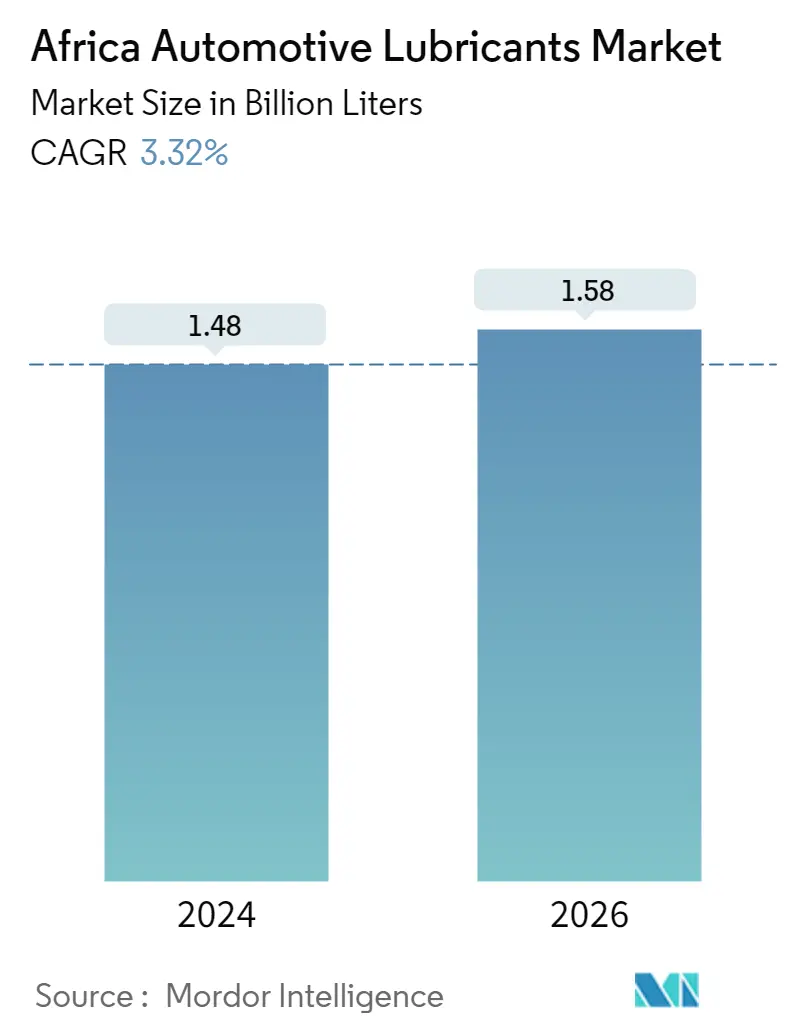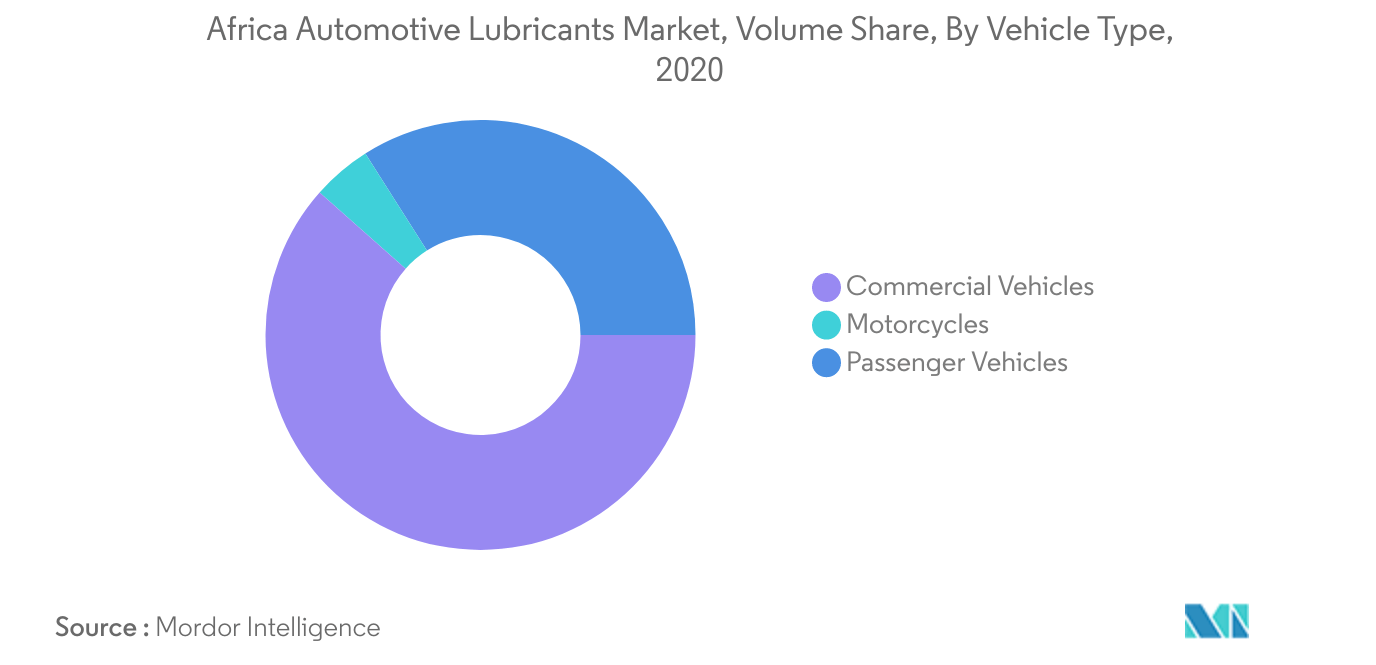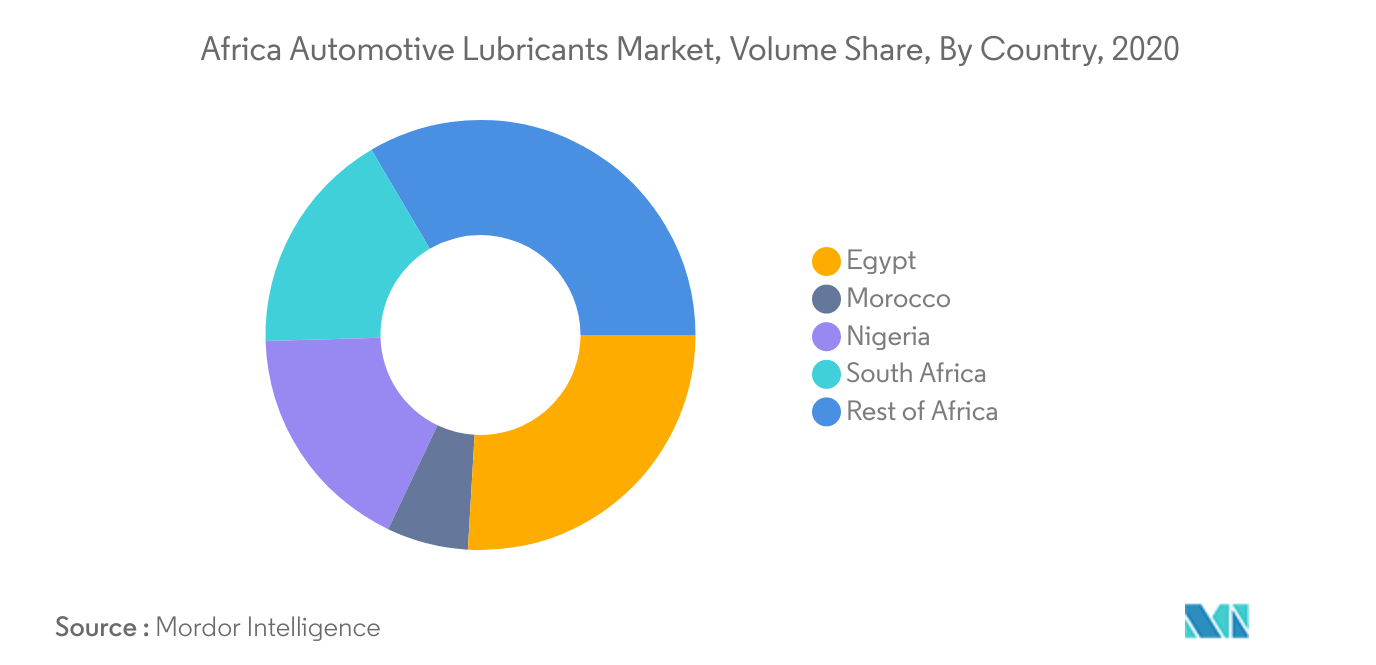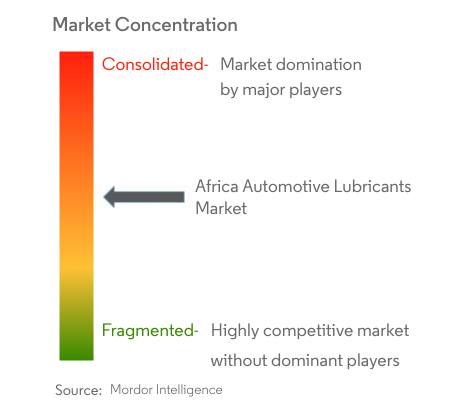Africa Automotive Lubricants Market Size

| Study Period | 2015 - 2026 |
| Base Year For Estimation | 2020 |
| Forecast Data Period | 2024 - 2026 |
| Historical Data Period | 2015 - 2019 |
| CAGR (2024 - 2026) | 3.32 % |
| Market Concentration | High |
Africa Automotive Lubricants Market Analysis
The Africa Automotive Lubricants Market size is estimated at 1.48 Billion Liters in 2024, and is expected to reach 1.58 Billion Liters by 2026, growing at a CAGR of 3.32% during the forecast period (2024-2026).
- Largest Segment by Vehicle Type - Commercial Vehicles : A large number of pickup trucks are employed for freight transportation throughout Africa. Africa's aging CV fleet has increased the demand for lubricants during service.
- Fastest Segment by Vehicle Type - Passenger Vehicles : Since 2020, there has been an increase in demand for used SUVs in African nations like Egypt, which is projected to augment lubricant consumption in passenger vehicles.
- Largest Country Market - Egypt : Egypt is the largest consumer of automotive lubricants among all African countries due to the high proportion of all used vehicles, such as SUVs, LCVs, and motorcycles.
- Fastest Growing Country Market - Morocco : Morocco is the fastest growing automotive lubricant consumer among all major African countries due to its constant growth in domestic production & motor vehicle registrations.
Africa Automotive Lubricants Market Trends
This section covers the major market trends shaping the Africa Automotive Lubricants Market according to our research experts:
Largest Segment By Vehicle Type : <span style="font-family: 'regular_bold';color:#0e7db3;">Commercial Vehicles</span>
- In the African region, the passenger vehicle (PV) segment accounted for almost 55% share among the total number of on-road vehicles during 2020, followed by motorcycles and commercial vehicles with 35% and 10% shares, respectively.
- The commercial vehicles segment accounted for the highest share of about 62% in the total automotive lubricant volume consumption in 2020, followed by the passenger vehicles segment with a share of 34%. During the same year, travel restrictions to curb COVID-19 significantly affected the usage of these vehicles and their lubricant consumption.
- During 2021-2026, the motorcycles lubricants segment is expected to witness the highest CAGR of 5.41%. The recovery of motorcycle sales and the easing of COVID-19-related travel restrictions are likely to be the key factors driving this trend.

Largest Country : <span style="font-family: 'regular_bold';color:#0e7db3;">Egypt</span>
- In Africa, automotive lubricant consumption is the highest in Egypt, followed by Nigeria and South Africa. In 2020, Egypt accounted for about 26% of the total automotive lubricant consumption, while Nigeria and South Africa accounted for shares of around 17.5% and 17%, respectively.
- The COVID-19 outbreak in 2020 significantly affected automotive lubricant consumption in many countries in the region. South Africa was the most affected, with a 9% drop, during 2019-2020, whereas Morocco was the least affected, with a 3.4% drop in its automotive lubricant consumption.
- During 2021-2026, Morocco is likely to be the fastest-growing lubricant market, as the consumption is likely to increase at a CAGR of 6.06%, followed by South Africa and Egypt, which are expected to record a CAGR of 3.57% and 3.33%, respectively.

Africa Automotive Lubricants Industry Overview
The Africa Automotive Lubricants Market is moderately consolidated, with the top five companies occupying 47.57%. The major players in this market are BP PLC (Castrol), Engen Petroleum Ltd, ExxonMobil Corporation, Royal Dutch Shell PLC and TotalEnergies (sorted alphabetically).
Africa Automotive Lubricants Market Leaders
-
BP PLC (Castrol)
-
Engen Petroleum Ltd
-
ExxonMobil Corporation
-
Royal Dutch Shell PLC
-
TotalEnergies
*Disclaimer: Major Players sorted in no particular order

Africa Automotive Lubricants Market News
- January 2022: Effective April 1, ExxonMobil Corporation was organized along three business lines - ExxonMobil Upstream Company, ExxonMobil Product Solutions and ExxonMobil Low Carbon Solutions.
- September 2021: Engen has made a ground-breaking development by launching its Engen App for the convenience of its customers. Engen will offer all its products and services through this app, making it easier for the consumers. This is expected to increase the sales of its lubricants and gain brand recognition in the region.
- August 2021: During 2017-2020, OLA Energy invested around EUR 200 million and established 80 new service stations every year across its pan-African network, including Gabon, Morocco, Kenya, Reunion, and Egypt.
Africa Automotive Lubricants Market Report - Table of Contents
1. Executive Summary & Key Findings
2. Introduction
- 2.1 Study Assumptions & Market Definition
- 2.2 Scope of the Study
- 2.3 Research Methodology
3. Key Industry Trends
- 3.1 Automotive Industry Trends
- 3.2 Regulatory Framework
- 3.3 Value Chain & Distribution Channel Analysis
4. Market Segmentation
-
4.1 By Vehicle Type
- 4.1.1 Commercial Vehicles
- 4.1.2 Motorcycles
- 4.1.3 Passenger Vehicles
-
4.2 By Product Type
- 4.2.1 Engine Oils
- 4.2.2 Greases
- 4.2.3 Hydraulic Fluids
- 4.2.4 Transmission & Gear Oils
-
4.3 By Country
- 4.3.1 Egypt
- 4.3.2 Morocco
- 4.3.3 Nigeria
- 4.3.4 South Africa
- 4.3.5 Rest of Africa
5. Competitive Landscape
- 5.1 Key Strategic Moves
- 5.2 Market Share Analysis
-
5.3 Company Profiles
- 5.3.1 Afriquia
- 5.3.2 Astron Energy Pty Ltd
- 5.3.3 BP PLC (Castrol)
- 5.3.4 Coperative Soceite des Petroleum
- 5.3.5 Engen Petroleum Ltd
- 5.3.6 ExxonMobil Corporation
- 5.3.7 Misr Petroleum
- 5.3.8 OLA Energy
- 5.3.9 Royal Dutch Shell PLC
- 5.3.10 TotalEnergies
- *List Not Exhaustive
6. Appendix
- 6.1 Appendix-1 References
- 6.2 Appendix-2 List of Tables & Figures
7. Key Strategic Questions for Lubricants CEOs
** Subject To AvailablityAfrica Automotive Lubricants Industry Segmentation
| By Vehicle Type | Commercial Vehicles |
| Motorcycles | |
| Passenger Vehicles | |
| By Product Type | Engine Oils |
| Greases | |
| Hydraulic Fluids | |
| Transmission & Gear Oils | |
| By Country | Egypt |
| Morocco | |
| Nigeria | |
| South Africa | |
| Rest of Africa |
Africa Automotive Lubricants Market Research FAQs
How big is the Africa Automotive Lubricants Market?
The Africa Automotive Lubricants Market size is expected to reach 1.48 billion Liters in 2024 and grow at a CAGR of 3.32% to reach 1.58 billion Liters by 2026.
What is the current Africa Automotive Lubricants Market size?
In 2024, the Africa Automotive Lubricants Market size is expected to reach 1.48 billion Liters.
Who are the key players in Africa Automotive Lubricants Market?
BP PLC (Castrol), Engen Petroleum Ltd, ExxonMobil Corporation, Royal Dutch Shell PLC and TotalEnergies are the major companies operating in the Africa Automotive Lubricants Market.
Which segment has the biggest share in the Africa Automotive Lubricants Market?
In the Africa Automotive Lubricants Market, the Commercial Vehicles segment accounts for the largest share by vehicle type.
Which country has the biggest share in the Africa Automotive Lubricants Market?
In 2024, Egypt accounts for the largest share by country in the Africa Automotive Lubricants Market.
What years does this Africa Automotive Lubricants Market cover, and what was the market size in 2023?
In 2023, the Africa Automotive Lubricants Market size was estimated at 1.41 billion Liters. The report covers the Africa Automotive Lubricants Market historical market size for years: 2015, 2016, 2017, 2018, 2019, 2020, 2021, 2022 and 2023. The report also forecasts the Africa Automotive Lubricants Market size for years: 2024, 2025 and 2026.
Africa Automotive Lubricants Industry Report
Statistics for the 2023 Africa Automotive Lubricants market share, size and revenue growth rate, created by Mordor Intelligence™ Industry Reports. Africa Automotive Lubricants analysis includes a market forecast outlook to 202 and historical overview. Get a sample of this industry analysis as a free report PDF download.



